 W
WA church parade is a military parade by service personnel or members of a uniformed organization for the purposes of attending religious services.
 W
WA procession is an organized body of people walking in a formal or ceremonial manner.
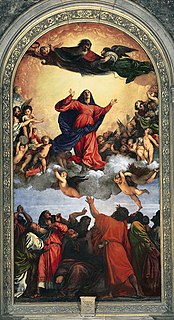 W
WThe Assumption of Mary into Heaven is, according to the beliefs of the Catholic Church, Eastern Orthodox Churches, Oriental Orthodoxy, Church of the East, and some Anglo-Catholic Churches, among others, the bodily taking up of Mary, the mother of Jesus, into Heaven at the end of her earthly life.
 W
WA baldachin, or baldaquin, is a canopy of state typically placed over an altar or throne. It had its beginnings as a cloth canopy, but in other cases it is a sturdy, permanent architectural feature, particularly over high altars in cathedrals, where such a structure is more correctly called a ciborium when it is sufficiently architectural in form. Baldachins are often supported on columns, especially when they are disconnected from an enclosing wall. A cloth of honour is a simpler cloth hanging vertically behind the throne, usually continuing to form a canopy. It can also be used for similar canopies in interior design, for example above beds, and for processional canopies used in formal state ceremonies such as coronations, held up by four or more men with poles attached to the corners of the cloth.
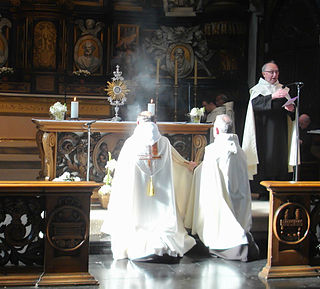 W
WBenediction of the Blessed Sacrament, also called Benediction with the Blessed Sacrament or the Rite of Eucharistic Exposition and Benediction, is a devotional ceremony, celebrated especially in the Roman Catholic Church, but also in some other Christian traditions such as Anglo-Catholicism, whereby a bishop, priest, or a deacon blesses the congregation with the Eucharist at the end of a period of adoration.
 W
WThe Blutritt is an equestrian procession in honor of a relic containing the blood of Jesus Christ. There are several cities in Germany holding Blutritte, however, the dates are not unified.
 W
WCandlemas, also known as the Feast of the Presentation of Jesus Christ and the Feast of the Purification of the Blessed Virgin Mary, is a Christian Holy Day commemorating the presentation of Jesus at the Temple. It is based upon the account of the presentation of Jesus in Luke 2:22–40. In accordance with Leviticus 12: a woman was to be purified by presenting lamb as a burnt offering, and either a young pigeon or dove as sin offering, 33 days after a boy's circumcision. It falls on February 2, which is traditionally the 40th day of and the conclusion of the Christmas–Epiphany season. While it is customary for Christians in some countries to remove their Christmas decorations on Twelfth Night, those in other Christian countries historically remove them on Candlemas. On Candlemas, many Christians also bring their candles to their local church, where they are blessed and then used for the rest of the year; for Christians, these blessed candles serve as a symbol of Jesus Christ, who referred to Himself as the Light of the World.
 W
WChristmas ships are boat parades held at Christmastime, typically featuring boats festooned with Christmas lights or winter/holiday decorations.
 W
WThe Christmas Ships Parade, or Christmas Ship Parade, is an annual Christmas ships parade in Portland, Oregon, United States. The tradition was established by a single boat in 1954. The 57th annual parade was held in 2019.
 W
WCorpse roads provided a practical means for transporting corpses, often from remote communities, to cemeteries that had burial rights, such as parish churches and chapels of ease. In Britain, such routes can also be known by a number of other names, e.g.: bier road, burial road, coffin line, coffin road, corpse way, funeral road, lych way, lyke way, or procession way. etc. Such "church-ways" have developed a great deal of associated folklore regarding ghosts, spirits, wraiths, etc.
 W
WThe Feast of Corpus Christi, also known as the Solemnity of the Most Holy Body and Blood of Christ, is a Roman Catholic, Anglican, and Western Orthodox liturgical solemnity celebrating the Real Presence of the Body and Blood, Soul and Divinity of Jesus Christ in the elements of the Eucharist. Two months earlier, the institution of the Eucharist at the Last Supper is observed on Maundy Thursday in a sombre atmosphere leading to Good Friday. The liturgy on that day also commemorates Christ's washing of the disciples' feet, the institution of the priesthood and the agony in the Garden of Gethsemane.
 W
WThe crucifix of San Marcello is a medieval work of religious art that is venerated in the Oratory of Santissimo Crocifisso of the Church of San Marcello al Corso in Rome. Having survived a fire that destroyed the church in 1519, the crucifix was popularly believed to possess intercessory powers. During an epidemic of plague in 1522 the crucifix was carried in a procession through the city. According to popular belief at the time, the procession caused the plague to leave the neighborhoods through which the crucifix passed, and eventually to die out in Rome.
 W
WEaster Week is the period of seven days from Easter Sunday through the Saturday following. It follows Holy Week. The term Octave of Easter includes Easter Week and the following Sunday.
 W
WIn Eastern Orthodox and Byzantine Catholic churches, an entrance is a procession during which the clergy enter into the sanctuary through the Holy Doors. The origin of these entrances goes back to the early church, when the liturgical books and sacred vessels were kept in special storage rooms for safe keeping and the procession was necessary to bring these objects into the church when needed. Over the centuries, these processions have grown more elaborate, and nowadays are accompanied by incense, candles and liturgical fans. In the liturgical theology of the Orthodox Church, the angels are believed to enter with the clergy into the sanctuary, as evidenced by the prayers which accompany the various entrances.
 W
WEpiphany is a Christian feast day that celebrates the revelation (theophany) of God incarnate as Jesus Christ.
 W
WThe Feast of the Ascension of Jesus Christ, also called Ascension Day, Ascension Thursday, or sometimes Holy Thursday, commemorates the Christian belief of the bodily Ascension of Jesus into heaven. It is one of the ecumenical feasts of Christian churches, ranking with the feasts of the Passion, of Easter, and Pentecost. Ascension Day is traditionally celebrated on a Thursday, the fortieth day of Easter, although some Christian denominations have moved the observance to the following Sunday. In the Catholic Church in the United States, the day of observance varies by ecclesiastical province.
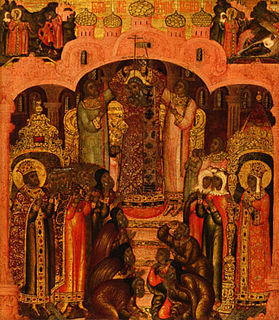 W
WIn the Christian liturgical calendar, there are several different Feasts of the Cross, all of which commemorate the cross used in the crucifixion of Jesus. Unlike Good Friday, which is dedicated to the passion of Christ and the crucifixion, these feast days celebrate the cross itself, as the sign of salvation. In Roman Catholicism, Eastern Orthodoxy, and Anglicanism the most common day of commemoration is September 14.
 W
WFuneral Procession is the name of a painting by Ellis Wilson, which went from obscurity to notoriety in 1986, when it was featured heavily in the episode "The Auction" of TV series The Cosby Show's second season. In the episode, Mrs. Huxtable wins the painting at an auction and pays $11,000 for it. She states that the painting was made by her "great-uncle Ellis". She said it hung in her grandmother's house and it was sold when her grandmother got sick and needed the extra money for medical bills. At the end of the episode, Dr. Huxtable hangs the painting over the family's living room mantle, where it would stay for the remainder of the eight-season series.
 W
WAmong Eastern Orthodox and Eastern-Rite Catholic Christians, holy water is used frequently in rites of blessing and exorcism, and the water for baptism is always sanctified with a special blessing.
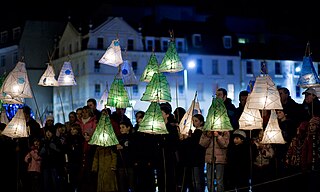 W
WAn illuminated procession is a procession held after dark so that lights carried by the participants form a spectacle. The lights will commonly be of the same type, so making a candlelight procession, lantern parade or torchlight march.
 W
WLammas Day, also known as Loaf Mass Day, is a Christian holiday celebrated in some English-speaking countries in the Northern Hemisphere on 1 August. The name originates from the word "loaf" in reference to bread and "Mass" in reference to the primary Christian liturgy celebrating Holy Communion. It is a festival in the liturgical calendar to mark the blessing of the First Fruits of harvest, with a loaf of bread being brought to the church for this purpose.
 W
WThe Lity or Litiyá is a festive religious procession, followed by intercessions, which augments great vespers in the Eastern Orthodox and Byzantine Catholic churches on important feast days. Following a lity is another liturgical action, an artoklasia, and either of these terms may be used to describe both liturgical actions collectively.
 W
WA medieval pageant is a form of procession traditionally associated with both secular and religious rituals, often with a narrative structure. Pageantry was an important aspect of medieval European seasonal festivals, in particular around the celebration of Corpus Christi, which began after the thirteenth century. This festival reenacted the entire history of the world, in processional performance, from Bible's Genesis to the Apocalypse, employing hundreds of performers and mobile scenic elements. Plays were performed on mobile stages, called waggons, that traveled through towns so plays could be watched consecutively. Each waggon was sponsored by a guild who wrote, designed, and acted in the plays.
 W
WOrange walks are a series of parades by members of the Orange Order, held on a regular basis during the summer in Ulster, Northern Ireland, and in other Commonwealth nations. The parades typically build up to 12 July celebrations marking Prince William of Orange's victory over King James II at the Battle of the Boyne in 1690. Although the term "march" or "parade" is widely used in the media, the Order prefers terms such as "walk" or "demonstration". Orange walks have faced opposition from Catholics, Irish nationalists and Scottish nationalists who see the parades as sectarian and triumphalist.
 W
WOur Lady of Trapani procession is an traditional festival that the Tunisian Christian community celebrates on the 15th of August of each year at Saint-Augustin and Saint-Fidèle's church in the city of La Goulette in Tunis.
 W
WA Paraklesis or Supplicatory Canon in the Byzantine Rite, is a service of supplication for the welfare of the living. It is addressed to a specific Saint or to the Most Holy Theotokos whose intercessions are sought through the chanting of the supplicatory canon together with psalms, hymns, and litanies.
 W
WThe Presentation of Jesus at the Temple is an early episode in the life of Jesus, describing his presentation at the Temple in Jerusalem in order to officially induct him into Judaism, that is celebrated by many Christian Churches on the holiday of Candlemas. It is described in the chapter 2 of the Gospel of Luke in the New Testament of the Christian Bible. Within the account, "Luke's narration of the Presentation in the Temple combines the purification rite with the Jewish ceremony of the redemption of the firstborn ."
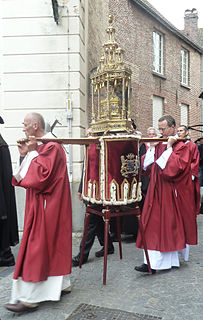 W
WThe Procession of the Holy Blood is a large religious Catholic procession, dating back to the Middle Ages, which takes place each Ascension Day in Bruges, Belgium. In 2009, it was included in the UNESCO Representative List of the Intangible Cultural Heritage of Humanity.
 W
WThe Sanctuary of Our Lady of Lourdes or the Domain is an area of ground surrounding the Catholic shrine (Grotto) to Our Lady of Lourdes in the town of Lourdes, France. The Sanctuary is a destination for pilgrimage; sick pilgrims are reputed to be miraculously healed by Lourdes water. This ground is owned and administered by the Roman Catholic Church, and has several functions, including devotional activities, offices, and accommodation for sick pilgrims and their helpers. The Domain includes the Grotto itself, the nearby taps which dispense the Lourdes water, and the offices of the Lourdes Medical Bureau, as well as several churches and basilicas. It comprises an area of 51 hectares, and includes 22 separate places of worship. There are six official languages of the Sanctuary: French, English, Italian, Spanish, Dutch and German.
 W
WTabot is a Ge'ez word referring to a replica of the Tablets of Law, onto which the Biblical Ten Commandments were inscribed, used in the practices of the Ethiopian Orthodox Church. Tabot can also refer to a replica of the Ark of the Covenant. The word tsellat refers only to a replica of the Tablets, but is less commonly used.